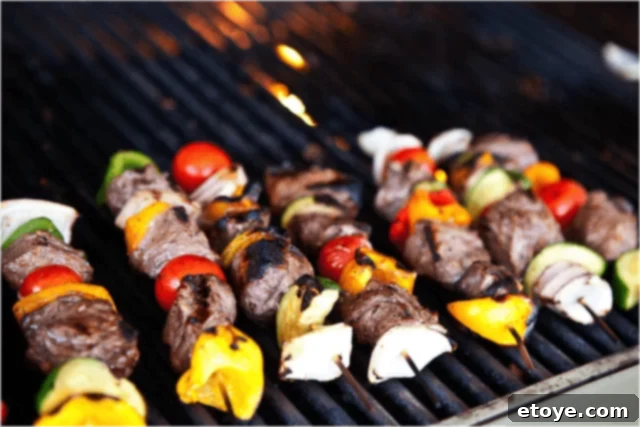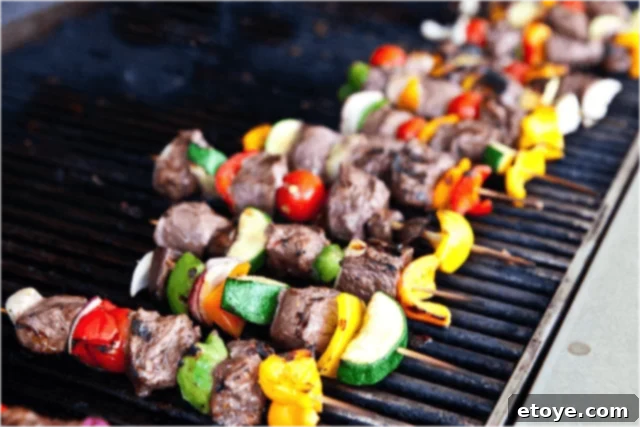
Savor the Flavor: Mastering Authentic Asian Steak Kabobs at Home
There’s an undeniable joy that comes with grilling kabobs – the vibrant colors, the tantalizing aroma, and the promise of a delicious meal on a stick. Lately, we’ve found ourselves embracing the kabob craze with full enthusiasm, inspired by the sheer versatility and fun these skewers offer. The idea of transforming a simple meal into an exciting culinary adventure on a stick is something truly special.
This culinary journey was particularly sparked by the innovative spirit of experts who champion the art of “food on a stick.” For anyone seeking to explore this delightful concept further, we highly recommend diving into books that celebrate this creative approach to cooking. The possibilities are endless, from savory delights like chicken and waffles on a stick to our flavorful Asian Steak Kabobs. You can discover more fascinating ideas and inspiration on Matt’s site, which often features unique culinary creations.
Click on photos to learn more about our culinary inspirations!
Inspired by innovative approaches to cooking, particularly those that elevate simple ideas, we often draw from a diverse range of sources. The culinary world is rich with talented individuals who continuously push the boundaries of flavor and presentation. For instance, the works of chefs like Adam Pearson, known for his creative techniques, often provide a spark for our own kitchen experiments. His passion for food is so infectious that even our kids aspire to emulate his culinary prowess when they grow up. These inspirations remind us that cooking is not just about following recipes, but about exploration and discovery.
My kids want to be Adam when they grow up.
The essence of our current kabob obsession truly stems from the incredible ideas found in various culinary guides. One such highly recommended resource is the book “On a Stick!”, a treasure trove of imaginative recipes perfect for grilling enthusiasts. It showcases how nearly anything can be deliciously prepared on a skewer, making meals both fun and easy to enjoy.
We highly encourage you to get this book! It’s filled with creative ideas that you’ll absolutely adore. Imagine “Chicken and Waffles on a Stick”? Yes, it’s as fantastic as it sounds! You can explore even more delightful photos and concepts from the book on Matt’s website, which is a great place for culinary inspiration. Now, let’s dive into creating our delicious Asian Steak Kabobs!
How to Make Delicious and SEO-Friendly Asian Steak Kabobs
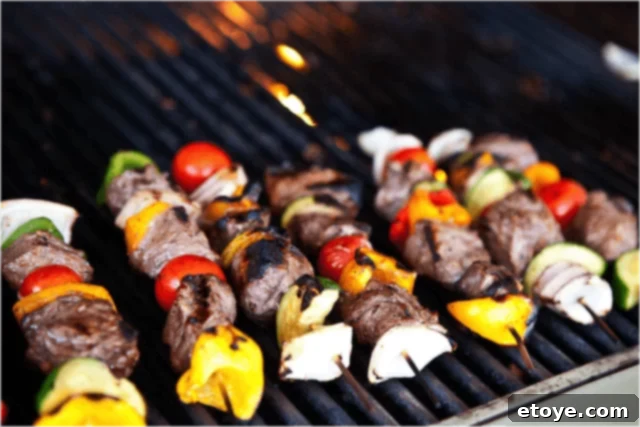
Let’s get back to the star of today’s show: the mouth-watering Asian Steak Kabobs. These skewers are more than just a meal; they’re an experience, combining tender beef with crisp vegetables, all infused with an exotic marinade. Achieving perfectly grilled kabobs requires attention to detail, from selecting the right ingredients to mastering the cutting and marinating techniques. Here’s a look at the key components we’ll be using for our exceptional kabobs:
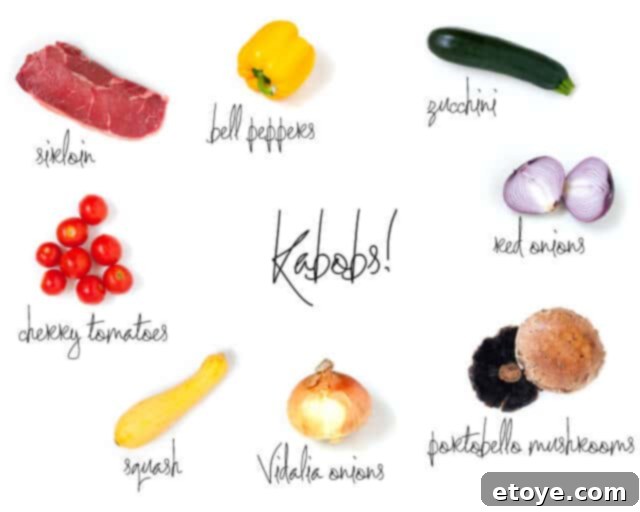
The Art of Crafting Perfect Kabobs: A Journey from Ingredient Selection to Grilling Excellence
Creating memorable kabobs starts long before they hit the grill. It involves thoughtful selection of ingredients, precise cutting, and a flavorful marinade. Let’s explore each step in detail.
Selecting Your Star: The Ideal Beef Cut for Asian Kabobs
For steak kabobs, your choice of beef cut is crucial for both flavor and texture. We consistently opt for sirloin, and for good reason. Sirloin steak is not only more economical but also boasts an intense, robust beefy flavor that stands up beautifully to bold marinades. Its natural shape lends itself perfectly to cutting into uniform kabob chunks with virtually no waste, ensuring consistency across all your skewers. When selecting sirloin, look for cuts with good marbling, which indicates a tender and juicy final product. We often source high-quality black angus sirloin steaks from trusted suppliers, ensuring a premium base for our delicious kabobs.
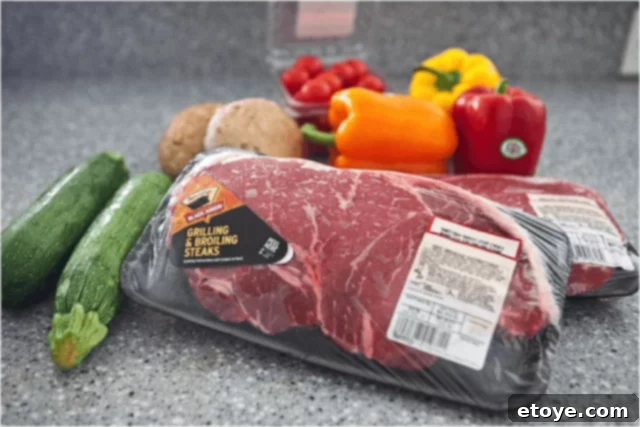
Preparing sirloin for kabobs is incredibly straightforward. Minimal effort is required; simply trim away any excess outer fat if you prefer a leaner cut. This step is optional but can help reduce flare-ups on the grill and cater to personal dietary preferences.

Once trimmed, cut the sirloin into uniform 1½-inch cubes. This size is ideal because it allows the meat to cook evenly and remain tender, while also fitting perfectly alongside your chosen vegetables on the skewer. Consistency in size is key to ensuring that every piece of steak reaches your desired level of doneness simultaneously.
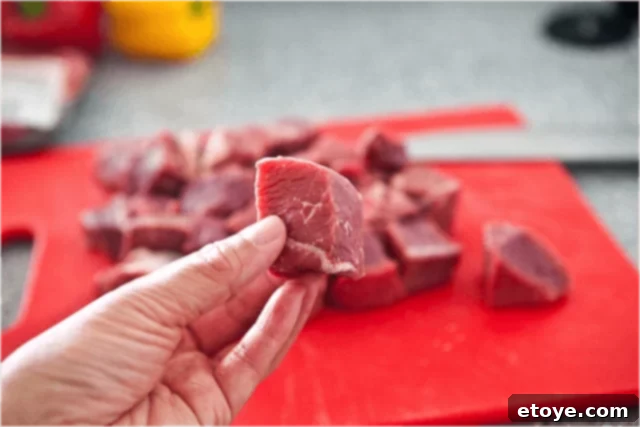
The Colorful Ensemble: Preparing Your Vegetables for Success
Crafting the perfect kabob isn’t just about selecting the right mix of vegetables; it’s also about how you meticulously cut them. The goal is to achieve harmony, ensuring both the steak and vegetables reach their optimal temperature and doneness at the same time. Imagine perfectly grilled steak complemented by crisp, tender vegetables, not charred edges or undercooked centers. Your choice of vegetables can be tailored to your family’s preferences, but the cutting technique remains paramount.
Let’s walk through the preparation for each vegetable to ensure a flawless grilling experience:
Zucchini or Yellow Squash: These delicate vegetables should be cut into ¾-inch thick rounds. If you have smaller squash, leaving them as full rounds works best. For larger, thicker squash, slicing them into half-moons ensures they aren’t too bulky and cook evenly. It’s vital not to cut them any thinner than ¾-inch, as their soft texture makes them prone to breaking easily when skewered and during grilling.

Bell Peppers: For a visually appealing and flavorful kabob, use a variety of bell pepper colors—red, green, orange, and yellow. Start by slicing each pepper in half lengthwise, removing the stem.

Next, use your fingers or a small paring knife to carefully remove the seedy core and any white membranes. This prevents bitterness and ensures clean pieces.

Slice each pepper half into 4 uniform strips. If your pepper is particularly small, 3 strips might be more appropriate. Consistency helps with even cooking.
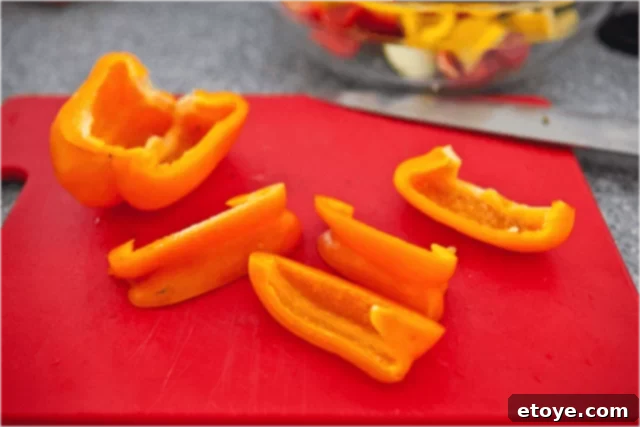
Finally, cut each strip into 3 roughly square-shaped pieces. These bite-sized portions will cook quickly and evenly alongside the steak.

Mushrooms: For mushrooms, we recommend the meaty texture of portobello. A common challenge with mushrooms is their delicate nature, making them prone to tearing during skewering. To combat this, choose large portobellos and slice them thickly—about 1-inch thick slices. Then, halve each slice. This robust cut helps them hold their shape and stay firm on the skewer.
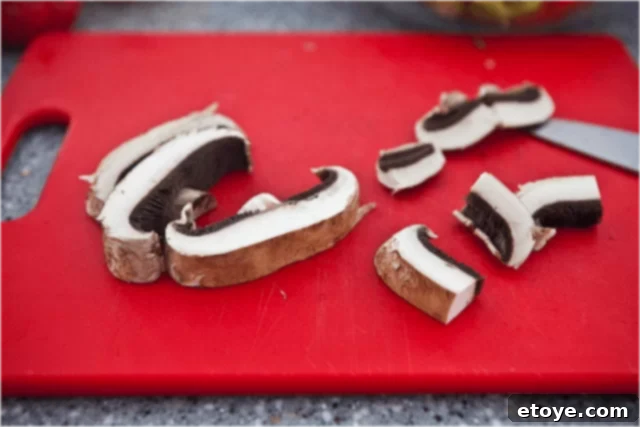
Onions: Both red onions and sweet Vidalia onions work wonderfully, offering distinct flavor profiles. Begin by cutting the onion in half, peeling away the outer skin, and trimming the stem end.
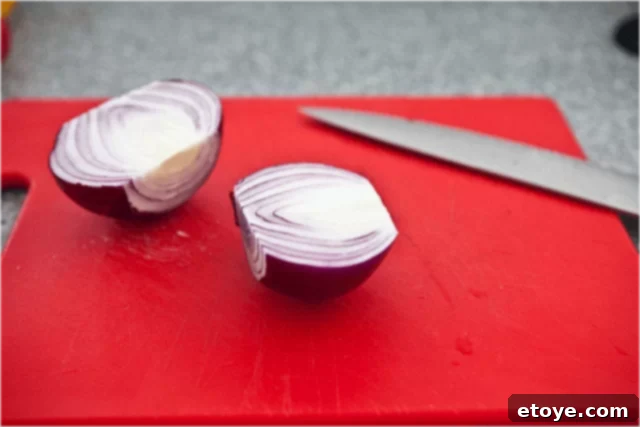
Cut each half into thirds, or in half if you’re using smaller onions. The goal is thick, sturdy wedges.
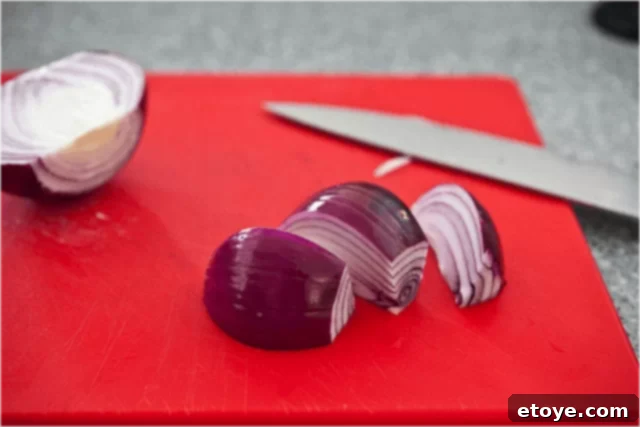
Then, cut each of these pieces in half again, creating smaller, manageable chunks that will soften nicely on the grill without falling apart.
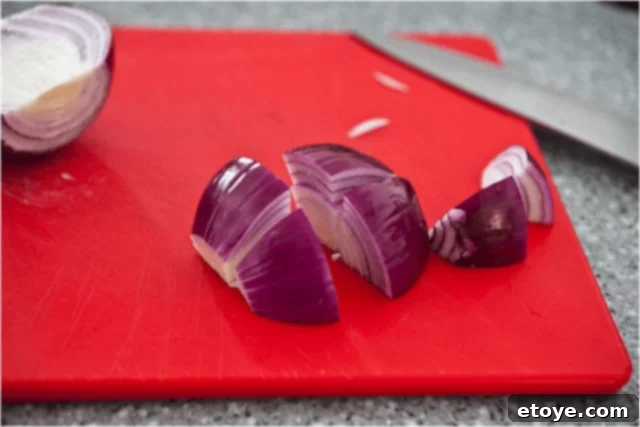
Cherry Tomatoes: These are best left whole. Their natural shape and size are perfect for kabobs, and they burst with juicy flavor when grilled. After preparing all your vegetables, place all of them EXCEPT the mushrooms into a large bowl. We’ll add the mushrooms in a specific way later to maintain their texture.
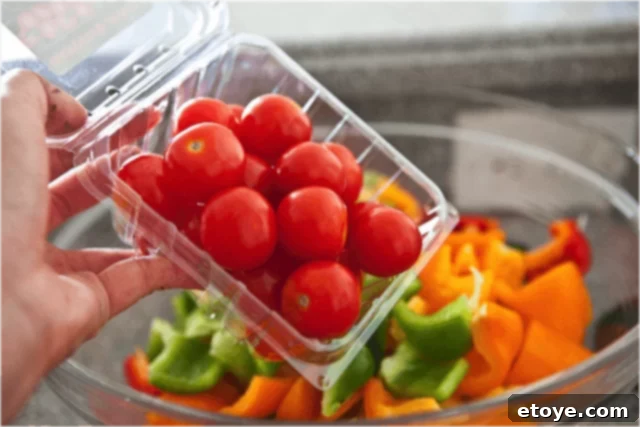
For an elevated flavor experience, we advocate for marinating the steak and vegetables separately, each in its own distinct sauce. This method allows each component to absorb unique flavors, resulting in a more complex and satisfying taste profile with every bite. For these Asian Steak Kabobs, we infuse them with a delightful Asian flair.
The Secret to Sizzle: Crafting an Irresistible Asian Marinade
A great marinade is the backbone of any delicious kabob. It tenderizes the meat, infuses it with flavor, and adds a beautiful caramelized crust during grilling. While you can certainly create your own marinade, there are also excellent store-bought options for convenience.
Homemade Asian Marinade: Crafting your own marinade is simple and allows for customization. A basic yet incredibly flavorful Asian marinade can be made with: 2 teaspoons freshly grated ginger + 2 garlic cloves, finely minced + 1 teaspoon sesame oil + 2 tablespoons soy sauce. Whisk these ingredients together, and you have a vibrant, aromatic marinade ready to transform your kabobs.

Store-Bought Marinade Convenience: If time is of the essence, high-quality store-bought dressings and marinades are fantastic shortcuts. Many brands offer delicious Asian-inspired options that are perfect for kabobs.
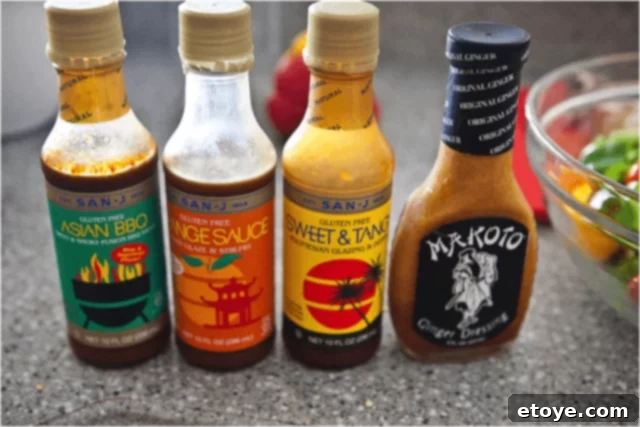
We’re particularly fond of San-J’s extensive line of Asian-style gluten-free marinades and dressings—their products are consistently excellent. Another favorite is Makoto Ginger Dressing, often found in the refrigerated produce section, which delivers a fresh, zesty flavor that truly enhances the beef. Using two different marinades—one for the steak and one for the vegetables—is a brilliant strategy. It ensures each element gets a distinct flavor boost, creating a delightful explosion of taste in every bite.
Pro Tip: Marinate the sirloin steak in one type of dressing and the vegetables in a different type – that way you get a big hit of flavor, distinct in each bite, creating a more dynamic culinary experience.
Marinating the Steak: Place all the sirloin cubes into a large bowl. Season them generously with salt and freshly ground black pepper. Then, pour in your chosen Asian dressing or marinade (for example, the Makoto Ginger Dressing). Toss to ensure every piece of beef is well-coated. Cover the bowl and refrigerate for a couple of hours, or preferably overnight, to allow the flavors to deeply penetrate the meat.

Marinating the Vegetables: For the prepared vegetables (excluding mushrooms), place them in another large bowl. Season with salt and pepper, then pour in your selected vegetable marinade (such as San-J Orange Sauce). Toss everything thoroughly to coat the vegetables evenly.

Now, carefully add the mushrooms on top of the marinated vegetables. Do NOT toss them with the other vegetables. Mushrooms are incredibly delicate and absorb liquids quickly. Tossing them would make them soggy, cause them to shrink excessively, and make them difficult to skewer and grill effectively. Keeping them relatively dry helps them retain their meaty texture.
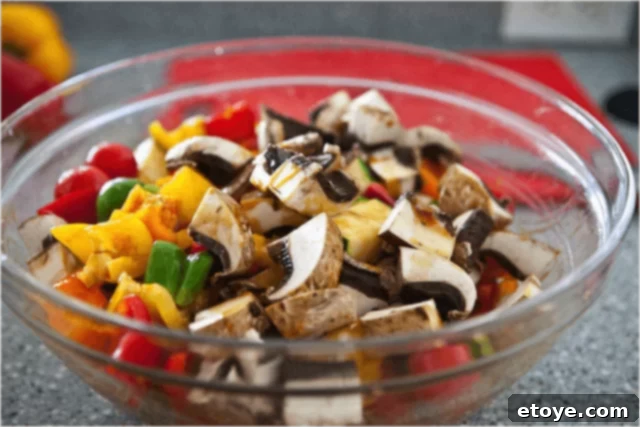
Cover both bowls. If you plan to marinate overnight, refrigerate them. However, if you’re only marinating for a few hours, it’s perfectly fine to let them sit on your kitchen counter, especially if refrigerator space is limited. Ensure they are covered to keep them fresh.
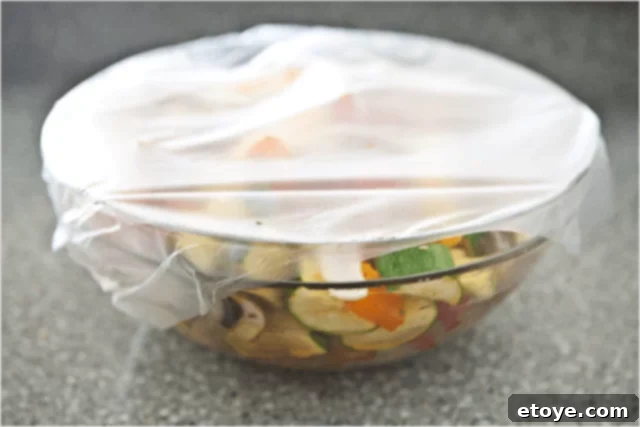
Skewering Smarts: Assembling Your Masterpiece
Once your ingredients are beautifully marinated, it’s time to assemble your skewers. If using bamboo skewers, remember to soak them in water for at least 30 minutes prior to use. This prevents them from burning on the grill. Alternate pieces of steak with various vegetables, ensuring an even distribution of colors and textures on each skewer. Don’t pack the ingredients too tightly; leave a small space between each piece to allow for even cooking and proper charring.
Grilling to Perfection: Achieving that Signature Char and Tenderness
The final step to mouth-watering Asian Steak Kabobs is mastering the grill. Proper grilling technique ensures that your steak is tender and juicy, and your vegetables are perfectly cooked with a delightful slight char.
Preheating the Grill: Before placing your kabobs, preheat your grill to create two heat zones: one side on high heat and the other on low heat. This two-zone setup is crucial for achieving both a beautiful sear and thorough, even cooking.
Searing and Finishing: Start your kabobs on the high heat side of the grill. Sear both sides for about 2-3 minutes per side, with the lid closed. This high heat will quickly caramelize the exterior of the steak and vegetables, locking in juices and developing rich flavors. Once seared, move the kabobs to the lower heat side to finish cooking. Cover the grill again and allow them to cook for another 5-10 minutes, depending on the desired doneness of your steak and the tenderness of your vegetables. For medium-rare steak, aim for an internal temperature of 130-135°F (54-57°C). Use a meat thermometer for accuracy. You’ll notice how beautifully the vegetables and meat cook in unison, thanks to the careful cutting preparation!
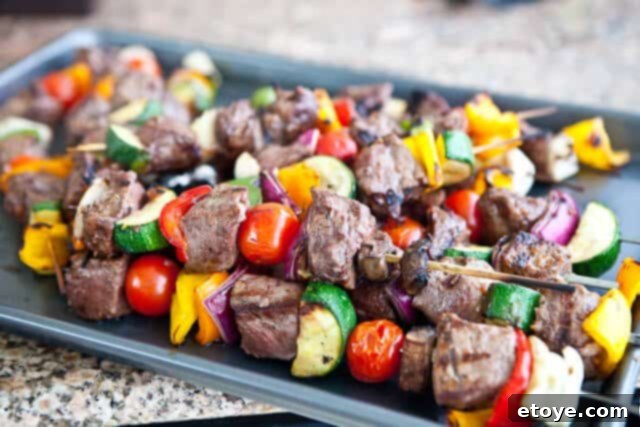
Resting the Kabobs: Once cooked to perfection, transfer the kabobs to a platter and tent them loosely with foil. Let them rest for 5-10 minutes. This allows the juices in the steak to redistribute, resulting in a more tender and flavorful bite. Serve hot and enjoy the incredible flavors of your homemade Asian Steak Kabobs!
Who’s coming for dinner tonight? These flavorful Asian Steak Kabobs are guaranteed to be a crowd-plepleaser, perfect for any gathering or a delightful family meal. Enjoy the fruits of your grilling labor!

Asian Steak Kabobs Recipe
Ingredients
- 3 pounds lean sirloin steak
- 3 bell peppers (various colors recommended)
- 1 red onion
- 1 sweet onion (Vidalia preferred)
- 1 pint cherry tomatoes
- 2 zucchini or yellow squash
- 2 large portobello mushrooms
- salt and freshly ground black pepper, to taste
- 1 cup Asian dressing or marinade of your choice (you can use two different types, ½ cup each for steak and vegetables)
- bamboo skewers (soaked in water for 30 minutes) or metal skewers
Instructions
- Cut the sirloin steak into 1½-inch cubes. Place the cubes in a large bowl, season with salt and pepper. Pour in ½ cup of your chosen Asian dressing or marinade. Toss to coat thoroughly. Cover the bowl and refrigerate for a couple of hours or up to overnight for best flavor.
- Slice the bell peppers, zucchini/squash, and onions as demonstrated in the photos above to ensure even cooking. Place all vegetables EXCEPT the portobello mushrooms into a separate large bowl. Season with salt and pepper. Pour in the remaining ½ cup of Asian dressing or marinade (or a different type if preferred). Toss well to coat. Gently place the sliced portobello mushrooms on top of the tossed vegetables, but do not toss them to prevent them from becoming soggy. Cover and refrigerate if marinating overnight. Otherwise, cover and let sit on the counter until ready to cook.
- If using bamboo skewers, ensure they have been soaked in water for at least 30 minutes. When ready to assemble, alternate the marinated steak cubes with the prepared vegetables on each skewer, leaving a small gap between each piece for even cooking.
- Preheat your grill, setting one side to high heat and the other to low heat. Place the assembled kabobs on the high heat side of the grill. Grill, covered, for 5 minutes to get a good sear. Then, flip the kabobs, cover, and grill for another 5 minutes. Move the kabobs to the low heat side to finish cooking through, covering the grill, for about 2-5 minutes more, depending on your desired level of steak doneness (130-135°F for medium-rare). Remove from grill and let rest for 5-10 minutes before serving.
